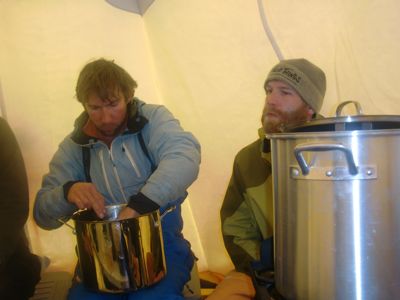This is Dominic Winski, a graduate student working on the Denali ice core project. We recently received a bunch of great questions from a high school science teacher and her students via satellite email. I will do my best to answer them below:
How accurate are the ice cores?
The accuracy with which we can reconstruct past climates from looking at ice cores depends on several different factors. First of all, we can learn about many kinds of climatic information from ice cores such as past temperatures, precipitation, and wind circulation among many other things. To learn about each of these variables, different methods are used, so the accuracy of the ice core depends in part upon the research question. Other factors such as the resolution of the record (how thick a year's worth of ice is), the care with which the cores are extracted and analyzed, and the complexity of the study site all play into the accuracy of conclusions. In general, results from ice cores agree with each other very well on long timescales. It could be said that ice cores are most useful at showing trends over hundreds and even thousands of years. Using ice cores to tell us what day to day weather in the past was like is much more difficult and has a lower degree of accuracy.

Why do you only take three ice cores? Does each core give you enough data?
Part of the point in taking multiple ice cores is to increase our confidence in the results. If we analyzed two or three cores and each shows us the same trends, we can be much more confident in our findings than if we had only one ice core to work with. Another reason is for security. If it happens that part of one ice core breaks, or melts in transit from Alaska to the laboratory than having multiple cores will ensure that data isn't lost. Finally, we do not plan to analyze all of the ice we collect. We will preserve some ice in an archive so that when future scientists have developed new methods for learning about climate from ice, they will have access to what we have collected this season.
Does global warming and ice melting affect the ice? Does the melting of the glacier affect your project?
Melting of glaciers and global warming is a very large concern for ice core scientists. In general, ice cores produce the best results when they are from areas that experience little or no melting whatsoever. When a glacier melts, even if it is just a small amount, that will change the physical and chemical properties of the ice that we rely on to interpret climate history. One of the most important reasons for selecting Mt. Hunter as a location to drill an ice core is that it is at high altitude making it a very cold place that almost never gets above freezing. As the climate of the earth warms, it will become increasing difficult to find ice core locations that are unaffected by melt.
What do you look at in the ice?
One of the biggest advantages of ice cores as a tool for teaching about climate is that we can look at many different components of the same piece of ice. This gives us a more complete picture of all that is happening in the climate system. In ice cores we look at both physical and chemical properties of the ice. Physical properties include ice density, amount of air bubbles in the ice, layering in the ice, including melt layers and dust and ash layers and many others. For chemical properties we look at the isotopes in the water (the weight of the atoms in the water molecules of the ice), ions trapped in the ice (such as calcium and sodium as examples), trace metals, and gases in the ice. Many studies also look for biology and microorganisms in ice as well. There are many more things that can be analyzed and certainly not every ice core (including ours) will analyze everything that can be measured. We are very interested in learning about how much snowfall has occurred in Alaska in the past, so we will probably place a heavy emphasis on water isotopes which will allow us to determine how much snow fell on Mt. Hunter each year and, perhaps, where the water that produced the snow actually originalted.
Thank you again for these great questions. I hope these answers make sense and are useful to everyone. Feel free to reach out anytime with additional questions.


Comments